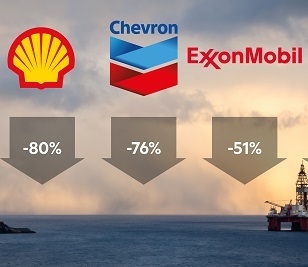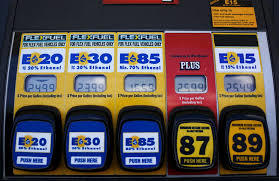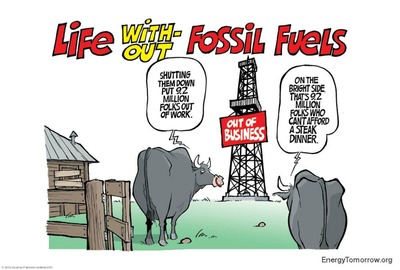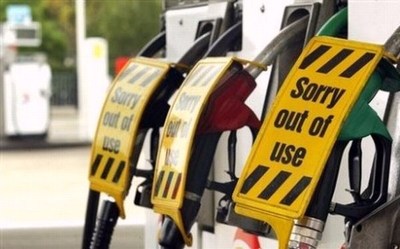Ethanol is the SAVIOR of the Oil Industry, Convenience Store Industry, Automotive Supply Chain Industry and Much More!
Originally published nearly FIVE YEARS AGO
By Bob Gordon and Marc Rauch
Co-Founders/Co-Publishers
THE AUTO CHANNEL
 Marc Rauch |
Some people believe that electric vehicles will become the dominant vehicles on the road within the next few years. Others believe that they will become the dominant vehicles in 40 or 50 years from now. Added together, almost all people believe that electric vehicles will become the dominant vehicles at some point in the foreseeable future. Media outlets and pundits are sounding the death knell of the internal combustion engine. And automakers are falling all over themselves in their blind rush to make it happen.
 Bob Gordon |
Except one little thing; well, one little enormous thing, actually: They mostly rely on fuels that cause terrible pollution, illnesses, and global instability. These problems are so severe that they've created the urgency to get rid of ICE vehicles altogether and to replace them with electric vehicles.
Don't throw the baby out with the bath water!
So what happens if and when electric vehicles become the sole or dominant vehicles...what happens when communities ban internal combustion vehicles from their roads (some already have)?
 |
What will happen is that the oil business is out of business...the convenience store filling station business is out of business...the ICE supply chain industry is out of business...manufacturers of engine treatment products are out of business...engine repair shops are out of business. Tens of thousands of businesses will be closed, millions of workers idled, millions of investors will lose their investments (in many cases their life savings).
All of these losses, all of this upheaval, all over internal combustion engines that are perfectly good machines.
Moreover, electric vehicles are not clean. There's plenty of pollution problems tied to electric vehicles, along with issues related to such things a slave labor mining for materials used to make batteries. Electric vehicle production is also not profitable for the manufacturers, and the only people who will seriously benefit from electric vehicles are the Chinese...the Communist Chinese.
There is a solution... a savior of the internal combustion engine and untold numbers of endangered people, families, and businesses.
 |
The solution, the savior, is ethanol. Adding ethanol to gasoline reduces pollution...it reduces the possibility of illnesses...it lessens the dependence on foreign sources of petroleum oil, which in turn lessens the availability to fund terrorism and start wars. And the more ethanol used, the more that these problems fade away.
Don't throw the baby out with the bath water!
This solution is so fantastic that it can be used immediately, in fact it is already being used as E10, E15 or E85 ethanol-gasoline blends. Flex-fuel E85 vehicles, which are virtually the same as non-flex fuel vehicles work, they are tried and proven.
Incredibly, the companies, their employees, and their investors who are at immanent risk of losing everything if internal combustion engines go away are only interested in spreading lies about ethanol. They're so busy bad-mouthing ethanol and trying to destroy the ethanol industry that they are simply sowing their own seeds to annihilation. You kill the ethanol industry, you kill the oil industry and every industry that's reliant on the use of internal combustion engines.
For years, The Auto Channel and many other intelligent and dedicated people and entities have debunked all the negative ethanol fuel myths. There is not one negative claim that the oil industry can make and substantiate against ethanol. Some oil people are even aware that the oil industry has marketed ethanol-gasoline fuels around the world for decades, and that ethanol has no negative characteristics. So stop the charade, admit that ethanol is great - just as Standard Oil and Cities Service did for all those decades in Britain
If we were you, Mike Sommers (CEO of American Petroleum Institute), and you Chet Thompson (CEO of American Fuel and Petrochemical Manufacturers association), and you Henry Armour (CEO of National Association of Convenience Stores, we'd immediately get on the phone to the people at Growth Energy and Renewable Fuel Association and American Coalition for Ethanol and Clean Fuels Development Coalition and say, "Hi partner, how can we work together with you folks?" You should get on the phone to individual distilleries and farm associations and see who is up for a round of golf.
Instead of trying to block E15 or E20 or E27 or E85, you should be demanding that President Trump and congress enact legislation that mandates higher ethanol use. You should be imploring the EPA to get out of the way. Mandatory E85 (85% ethanol and 15% gasoline) might mean just G15 to you, oil industry, but G15 is still a whole lot better than G0. And if E85 (or G0) was being used by every internal combustion engine it would alleviate the EV frenzy that will kill the internal combustion engine, the oil industry, and every industry that provides products and services needed for internal combustion engines.
Mike Sommers, Chet Thompson, and Henry Armour, you should contact all the media people and academics you've paid over the years to bash ethanol and tell them "ix-nay e-thay ethanol-yay ashing-bay." That's Pig Latin for "nix the ethanol bashing."
• If you put ethanol workers out of their jobs, you'll wind up putting oil workers out of their jobs.
• If you kill ethanol companies and farmers, you'll kill all oil related businesses.
• If you kill ethanol company investors, you'll kill the oil company investors.
• Save the internal combustion engine along with yourselves.
There's nothing wrong with the internal combustion engine that a better fuel won't fix. Don't throw the baby out with the bath water!
For those reading this outside of America, the same is precisely true for you. Save your workers and companies, demand ethanol.
 |
For a lot more information about ethanol fuel you can read Marc's 641-page book, THE ETHANOL PAPERS. It's available to read online for free by CLICKING HERE.
SEE ALSO Electric Vehicles Solution Or Diversion Or Chinese Tulip Frenzy?
Are electric cars worse for the environment?
Crunch the numbers, and it looks like all those subsidies might be counterproductive.
Special To The Auto Channel
From Politico.Com
Agenda From JONATHAN LESSER
May 15. 2019: If you believe the headlines, traditional automobiles are speeding toward a dead end. All those V8s, V6s and turbocharged vehicles we’ve grown to love will soon be replaced by squadrons of clean, whisper-quiet, all-electric vehicles. And if you believe the headlines, the environment will be much better off.
Policymakers at every level have done their part to push electric vehicles by creating a tankful of subsidies. Thanks to laws signed by both George W. Bush and Barack Obama, electric-vehicle buyers can feast on federal tax credits of up to $7,500 that reduce the initial purchase cost of their vehicles. Not to be outdone, many states also dangle their own mix of goodies for electric vehicle buyers, including purchase rebates as large as $5,000, additional rebates for vehicle chargers, and free use of public charging stations—which, of course, are only “free” because they’re subsidized by ratepayers and taxpayers. Some states even give electric vehicles preferential access to carpool lanes.
Then there are the electric vehicle mandates. In January, California Gov. Jerry Brown decreed that 5 million electric vehicles must be on his state’s roads by 2025, along with 250,000 charging stations. Eight other states are following California’s lead. One California lawmaker has even introduced legislation to ban all internal combustion vehicles by 2040.
All of this might make sense if electric vehicles, as their supporters claim, were truly likely to reduce air pollution and tackle climate change. But are they?
To answer that question, I used the U.S. Energy Information Administration’s most recent long-term forecasts for the number of new electric vehicles through 2050, estimated how much electricity they’d use, and then figured out how much pollution that electricity would generate, looking at three key pollutants regulated under the U.S. Clean Air Act—sulfur dioxide (SO2), oxides of nitrogen (NOX), and particulates—as well as CO2 emissions. I compared them to the emissions of new gasoline-powered vehicles, using the EIA’s “real world” miles-per-gallon forecast, rather than the higher CAFE standard values.
What I found is that widespread adoption of electric vehicles nationwide will likely increase air pollution compared with new internal combustion vehicles. You read that right: more electric cars and trucks will mean more pollution.
That might sound counterintuitive: After all, won’t replacing a 30-year old, smoke-belching Oldsmobile with a new electric vehicle reduce air pollution? Yes, of course. But that’s also where many electric vehicle proponents’ arguments run off the road: they fail to consider just how clean and efficient new internal combustion vehicles are. The appropriate comparison for evaluating the benefits of all those electric vehicle subsidies and mandates isn’t the difference between an electric vehicle and an old gas-guzzler; it’s the difference between an electric car and a new gas car. And new internal combustion engines are really clean. Today’s vehicles emit only about 1% of the pollution than they did in the 1960s, and new innovations continue to improve those engines’ efficiency and cleanliness.
And as for that electric car: The energy doesn’t come from nowhere. Cars are charged from the nation’s electrical grid, which means that they’re only as “clean” as America’s mix of power sources. Those are getting cleaner, but we still generate power mainly by burning fossil fuels: natural gas is our biggest source of electricity, and is projected to increase. And coal, while still declining, will remain the second largest source of electricity for some time. (Third is nuclear power, which doesn’t generate emissions but has other byproducts that worry some environmentalists.) Even with large increases in wind and solar generation, the EIA projects that the nation’s electric generating mix will be just 30% renewable by 2030. Based on that forecast, if the EIA’s projected number of electric vehicles were replaced with new internal combustion vehicles, air pollution would actually decrease—and this holds true even if you include the emissions from oil refineries that manufacture gasoline.
As for states like California with stringent mandates to use more renewable energy for their power grid, they also have the highest electric rates in the continental US, 50% higher than the US average. And electric rates in those states just keep increasing. So it’s a cleaner power mix, but makes recharging your car more expensive. The higher the electric rate, the lower the incentive for a new car buyer to purchase an electric vehicle.
As for greenhouse-gas emissions, my analysis shows that electric vehicles will reduce them compared to new internal combustion vehicles. But based on the EIA’s projection of the number of new electric vehicles, the net reduction in CO2 emissions between 2018 and 2050 would be only about one-half of one percent of total forecast U.S. energy-related carbon emissions. Such a small change will have no impact whatsoever on climate, and thus have no economic benefit.
So, if electric-vehicle subsidies don’t help the environment, what—or who—do they help? Most electric-vehicle buyers are far wealthier than average Americans. A nationwide survey in 2017 found that 56% had household incomes of at least $100,000 and 17% had household incomes of at least $200,000. (In 2016, median household income for the US as a whole was less than $58,000.) So it’s fair to say the subsidies disproportionately benefit the wealthy at the expense of the poor, who cannot afford to buy even subsidized electric vehicles or live in their own homes to take advantage of residential chargers or solar panels.
Not only that, the wires and charging stations needed to charge all those electric vehicles will be paid for by all ratepayers, further raising electric rates. And as more wealthy customers install solar panels to charge their electric vehicles, the costs to provide them back-up power will fall on those who cannot afford to do so.
In effect, the wealthy owners of electric vehicles will enjoy the benefits of their clean, silent cars, while passing on many of the costs of keeping their vehicles on the road to everyone else, especially the poor.
To be sure, electric cars are impressive. Some are quicker off the line than a Formula 1 race car. But there is no economic or environmental justification for the many billions of dollars in subsidies that America is already paying to speed their adoption.
So what to do? First, Congress should immediately terminate those electric-vehicle tax credits, which just benefit the wealthy. Congress should also eliminate zero-emissions credits, which electric-vehicle manufacturers have used to boost their bottom line – $860 million for Tesla alone in the last three years. And third, states should eliminate their various subsidies for electric vehicles and charging infrastructure, which are also paid for disproportionately by the poor and are contributing to rising electric rates.
Electric vehicle subsidies and mandates share an unfortunate, and all too common trait with other government policies: They’re based on “conventional wisdom” that turns out to be wrong. Wealthy consumers who have purchased Teslas and Chevy Bolts primarily to signal their green bona fides for their friends and neighbors, and who have socialized many of the costs of their purchases to those who are less well-off, might wish to take a closer look at the numbers. Their hands may not be quite so clean as they believe.
Jonathan Lesser is the President of Continental Economics, an economic and regulatory consulting firm. His new report, “Short Circuit: The High Cost of Electric Vehicle Subsidies” was published by the Manhattan Institute on May 15.
- Tail Pipe Emissions? What Really Needs To Be Fixed" +VIDEO
- "If We Win, No More ICE Powered Vehicles" - A Good Reason To Not Vote For Know Nothing Democrats
- General Motors: How ICE Business Is Funding The Future And Reducing Financial Risk
Editor's Note: Our vision of the ubiquitous mobility fuel future; 50-75 years out - Hydrogen Fuel-Cell Power, Now until then Clean Internal Combustion Engine Power. There's nothing wrong with the Internal Combustion Engine that a better fuel won't fix. Don't throw the baby out with the bath water! Only China, California And Sycophant Politicians Are Pushing To Replace Internal Combustion Engine Power With BEV's Made By Chinese Government Owned Or Controlled Electric Vehicle Auto Builders Utilizing China Monopolized Lithium...I Say Fight Them, Free People Everywhere Should Not Allow China And Their Allies To F up our Freedom Of Mobility
The end of the internal combustion engine will have disastrous consequences
for millions of workers and investors
for millions of workers and investors
SEE ALSO: A True American Hero
SEE ALSO: The End Of
The Internal Combustion Engine? Really? - Expert's Editorial





